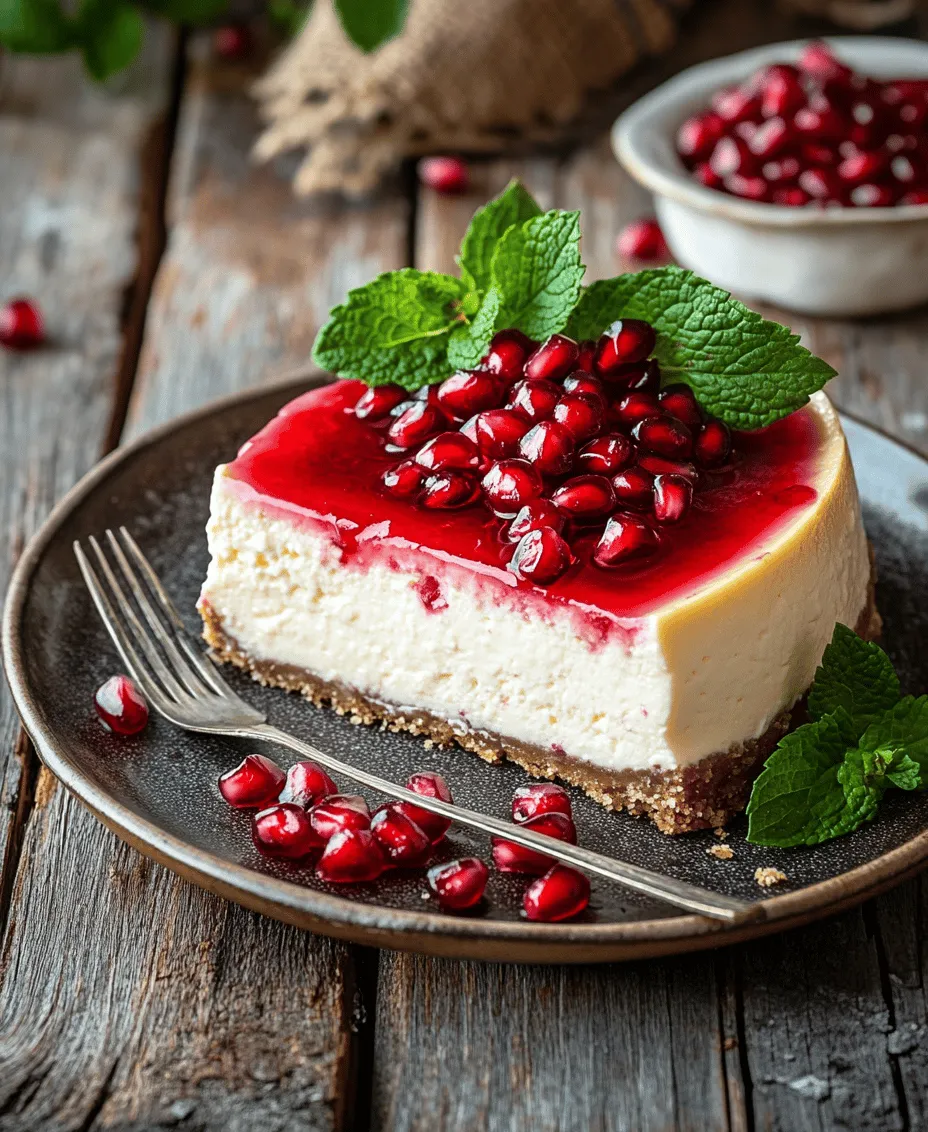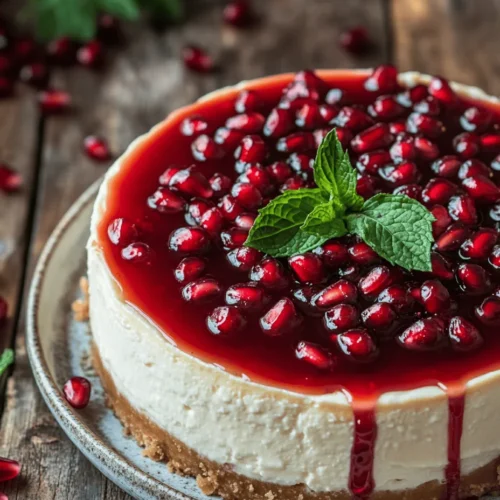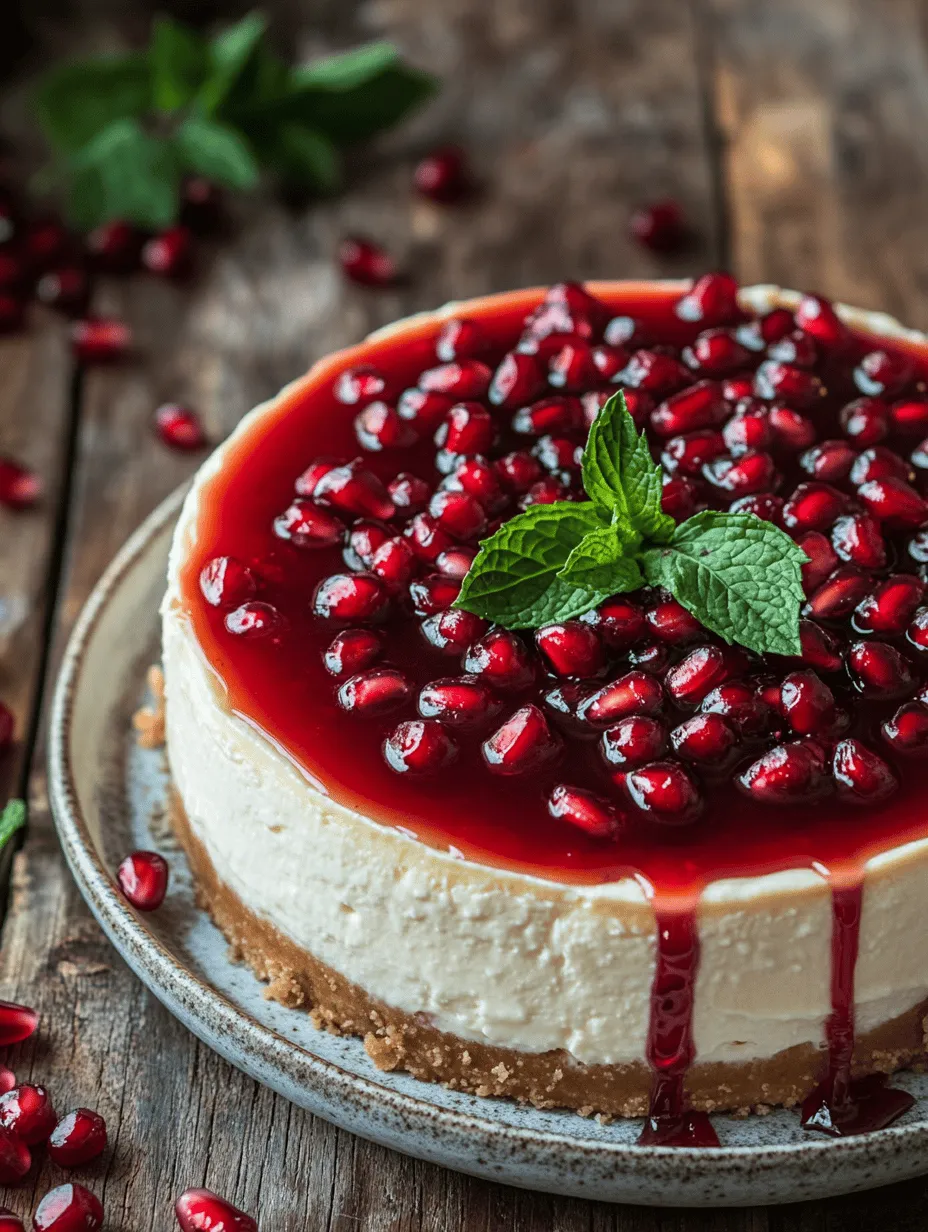Introduction
Delve into the world of decadent desserts with this delightful Greek Yogurt Cheesecake topped with a luscious pomegranate syrup. This unique twist on the classic cheesecake combines the creamy texture of Greek yogurt and cream cheese with the refreshing tartness of pomegranate, making it a perfect treat for any occasion—birthdays, holidays, or simply a cozy evening at home. By incorporating Greek yogurt into the recipe, we not only enhance the flavor profile but also add nutritional benefits that traditional cheesecakes often lack.
Greek yogurt has gained immense popularity in the culinary world, particularly in dessert recipes, due to its ability to provide a rich, creamy texture while being lower in fat than heavy cream. This cheesecake is not just a dessert; it’s a celebration of flavors and health-conscious choices. In this article, we will guide you through the recipe step-by-step, providing insights into the ingredients, baking techniques, and the benefits of using Greek yogurt in cheesecake.
Understanding the Ingredients
Exploring the Core Components of the Cheesecake
To create a Greek Yogurt Cheesecake that is both delicious and satisfying, it’s essential to understand the role of each ingredient. Each component contributes to the overall flavor, texture, and structure of the cheesecake, ensuring that every bite is a delightful experience.
The Role of Greek Yogurt
Greek yogurt is the star of this cheesecake, elevating it above the traditional versions. Its high protein content and creamy consistency offer a rich base that complements the other ingredients beautifully.
– Nutritional Benefits: Greek yogurt is packed with protein, probiotics, and essential nutrients like calcium and potassium. This makes it a healthier alternative to sour cream or heavy cream, allowing you to indulge without the guilt.
– Texture and Flavor Enhancement: The tangy flavor of Greek yogurt adds depth to the cheesecake, making it more complex and interesting. Its creamy texture helps achieve a smooth, velvety finish, which is crucial for a successful cheesecake.
Cream Cheese: The Classic Cheesecake Essential
While Greek yogurt serves as a healthier base, cream cheese is a must-have for that classic cheesecake flavor.
– Choosing the Right Cream Cheese: Opt for full-fat cream cheese for the creamiest results. Brands may vary in flavor and texture, so it’s worth experimenting with a few until you find your favorite.
Sugar: Sweetening to Perfection
Sugar is an essential ingredient in creating the right balance of sweetness for the cheesecake.
– Alternatives for Healthier Options: If you’re looking to reduce sugar intake, consider alternatives like honey, agave syrup, or coconut sugar. Each will impart a slightly different flavor, so choose one that complements your taste preferences.
Vanilla Extract: Adding Depth to Flavor
Vanilla extract enhances the overall flavor profile of your cheesecake.
– Importance of Quality Vanilla: Always choose pure vanilla extract over synthetic options. The rich, aromatic notes of pure vanilla elevate the dessert, making it more enjoyable.
Fresh Eggs: Binding and Structure
Eggs play a crucial role in binding the ingredients together and providing structure to the cheesecake.
– The Science Behind Egg Incorporation: Eggs help to stabilize the cheesecake, ensuring it sets properly during baking. Incorporating them at room temperature will yield the best results, as they blend more easily into the batter.
Flour: The Secret to Stability
A small amount of flour is often included in cheesecake recipes to ensure stability.
– Why Flour is Essential in Cheesecakes: Flour helps to thicken the batter, allowing the cheesecake to hold its shape without becoming dense. It provides a slight structure that is necessary for the perfect slice.
Crafting the Perfect Crust
A delicious cheesecake isn’t complete without a flavorful crust. The base of your Greek Yogurt Cheesecake is just as important as the filling, and a well-crafted crust can take your dessert to the next level.
Creating a Flavorful Base for Your Cheesecake
Selecting the Right Type of Graham Crackers
Graham crackers are the traditional choice for cheesecake crusts, but variations can add unique flavors.
– Variations and Flavor Options: Experiment with different types of crackers, such as chocolate or cinnamon graham crackers, to add a twist to your crust. Alternatively, consider using crushed nuts or cookies for a gluten-free option.
The Importance of Melting Butter
Butter is the key ingredient that binds the graham cracker crumbs together.
– Achieving the Ideal Consistency: Melted butter should be combined with the crumbs until they resemble wet sand. This ensures the crust holds together during baking and slicing.
Baking Techniques for a Flaky Crust
To achieve a perfectly flaky crust, follow these baking techniques:
– Tips for Even Baking: Pre-bake the crust for about 10 minutes at 350°F (175°C) to set it before adding the cheesecake filling. This step helps prevent a soggy crust and ensures a delightful crunch.
Step-by-Step Guide to Making Greek Yogurt Cheesecake
Now that we’ve discussed the ingredients and crust, let’s dive into the step-by-step process of creating your Greek Yogurt Cheesecake topped with pomegranate syrup.
Prepping the Oven and Springform Pan
1. Preheat the Oven: Start by preheating your oven to 325°F (160°C). This lower temperature allows for even baking without cracking the cheesecake.
2. Prepare the Springform Pan: Grease the sides of a 9-inch springform pan with butter or cooking spray for easy removal. You may also line the bottom with parchment paper to further prevent sticking.
3. Gather Your Ingredients: Assemble all the ingredients and tools you will need, including a mixing bowl, a whisk, and a spatula. Having everything on hand will streamline the process.
Follow this guide, and you will be well on your way to creating a stunning Greek Yogurt Cheesecake with Pomegranate Syrup. As you progress through the steps, remember to enjoy the process and savor the delightful flavors that come together in this unique dessert. The combination of creamy cheesecake with the vibrant, tangy pomegranate syrup is sure to be a crowd-pleaser, making it a recipe you’ll want to share and repeat.

Importance of Temperature and Pan Preparation
Before diving into the cheesecake batter, let’s address two crucial elements: temperature and pan preparation. Cheesecake batter benefits from using ingredients at room temperature. This allows for better mixing and ensures that your cheesecake becomes a smooth, creamy delight. Remove your cream cheese and Greek yogurt from the refrigerator about an hour before you start baking.
Pan preparation is equally important. To prevent sticking, line the bottom of your springform pan with parchment paper and lightly grease the sides. This will make it easier to release the cheesecake once it’s baked and cooled. Additionally, wrapping the outside of the pan with aluminum foil can help prevent water from seeping in during the water bath baking method, which is essential for achieving a creamy texture.
Mixing the Cheesecake Batter
Once your ingredients are at room temperature and your pan is ready, it’s time to mix the cheesecake batter. Start by beating the cream cheese until it’s light and fluffy, which usually takes about 3-5 minutes. This step is essential; it incorporates air into the mixture, giving you a lighter cheesecake.
Next, add in the Greek yogurt, sugar, vanilla extract, and a pinch of salt. Mix until well combined, scraping down the sides of the bowl as necessary. Incorporating Greek yogurt not only enhances the flavor but also adds a tangy depth that elevates the cheesecake beyond the traditional version.
Techniques for Achieving a Smooth Mixture
To ensure your cheesecake batter is as smooth as possible, avoid over-mixing, which can incorporate too much air and lead to cracks during baking. Instead, mix the batter on low speed until combined. If you notice any lumps after mixing, consider using a hand mixer or even a whisk for a brief moment to smooth it out without overworking the batter.
Pouring and Baking
Once your batter is smooth, pour it into the prepared springform pan. Using a spatula, gently spread it to ensure an even layer. For the baking process, you will use a water bath to create a humid environment, which helps the cheesecake cook evenly and prevents it from cracking.
To create a water bath, place the springform pan in a larger baking dish and fill the outer dish with hot water until it reaches halfway up the sides of the springform pan. Bake the cheesecake at a low temperature, around 325°F (160°C), for approximately 50-60 minutes. The cheesecake should be set around the edges but still slightly jiggly in the center.
How to Achieve the Perfect Bake Without Cracking
The key to avoiding cracks in your cheesecake lies in the baking method and cooling process. Baking at a lower temperature and using a water bath helps immensely. Additionally, don’t open the oven door during baking; sudden temperature changes can cause the cheesecake to crack.
Once the baking time is complete, turn off the oven and crack the oven door, allowing the cheesecake to cool slowly inside. This gradual cooling helps the cheesecake maintain its structure and prevents cracking.
Cooling Techniques for Optimal Texture
After the cheesecake has cooled in the oven for about an hour, remove it from the water bath and allow it to cool at room temperature for another hour. Then, cover it gently with plastic wrap and refrigerate for at least four hours or overnight. This chilling period allows the flavors to meld and the cheesecake to firm up, achieving that perfect creamy texture.
Why Gradual Cooling Matters
Gradual cooling is a crucial step in the cheesecake-making process. It helps to stabilize the filling and reduces the likelihood of cracks. Additionally, cooling the cheesecake slowly allows it to set properly without becoming rubbery. If you rush this step, you might end up with a cheesecake that’s too soft or has unsightly cracks on the surface.
Creating the Pomegranate Syrup
Enhancing your Greek yogurt cheesecake with a fruity topping like pomegranate syrup not only adds a burst of flavor but also elevates the presentation.
Ingredient Breakdown for the Syrup
For the pomegranate syrup, you will need:
– 1 cup of fresh pomegranate juice (about 2-3 pomegranates)
– 1/2 cup of granulated sugar
– 1 tablespoon of lemon juice
Pomegranate Juice: Sourcing and Quality
When sourcing pomegranate juice, opt for fresh juice if possible. If you can’t find fresh pomegranates, select a high-quality bottled juice that contains no added sugars or preservatives. The flavor of the syrup will depend heavily on the quality of the juice.
Cooking Method for the Syrup
To make the syrup, combine the pomegranate juice, sugar, and lemon juice in a small saucepan over medium heat. Stir gently until the sugar is dissolved. Bring the mixture to a gentle simmer, then reduce the heat to low, allowing it to cook for about 15-20 minutes or until it has reduced by half and thickened slightly.
How Reduction Enhances Flavor
Reducing the syrup concentrates the flavors, making it richer and enhancing its natural sweetness. The addition of lemon juice balances the sweetness with a touch of acidity, resulting in a syrup that pairs beautifully with the creamy cheesecake.
Drizzling and Garnishing for Presentation
Once the syrup has cooled, you can drizzle it over the chilled cheesecake just before serving. For an elegant finish, consider garnishing with fresh pomegranate seeds and a sprig of mint. This not only adds a pop of color but also enhances the overall presentation of your dessert.
Nutritional Benefits of Greek Yogurt Cheesecake
This Greek yogurt cheesecake is not just a decadent dessert; it also offers several nutritional benefits compared to traditional cheesecake.
Comparing Traditional Cheesecake to Greek Yogurt Version
Traditional cheesecakes often contain heavy cream and more sugar, leading to higher calories and fat content. In contrast, using Greek yogurt lowers the calorie count while still providing a creamy texture and rich flavor. The addition of Greek yogurt also increases protein content, making this dessert more satisfying.
Caloric and Nutritional Differences
A typical slice of traditional cheesecake can range from 300 to 500 calories, while a slice of Greek yogurt cheesecake can be around 200 to 350 calories, depending on the specific recipe and portion size. The use of Greek yogurt significantly reduces sugar content and increases protein, making it a more balanced choice for dessert lovers.
The Role of Pomegranate as a Superfood
Pomegranates are often referred to as a superfood due to their high antioxidant content, particularly punicalagins and anthocyanins. These antioxidants help combat oxidative stress and inflammation in the body. Additionally, pomegranates are rich in vitamins C and K, as well as fiber, making this syrup a nutritious complement to your cheesecake.
Antioxidants and Health Benefits
The antioxidants found in pomegranates have been linked to various health benefits, including improved heart health, enhanced memory function, and even anti-cancer properties. By incorporating pomegranate syrup into your dessert, you not only enhance the flavor but also add a healthful element to your meal.
Serving Suggestions and Pairings
To elevate your Greek yogurt cheesecake experience, consider creative serving suggestions and perfect pairings.
Ideal Accompaniments for Cheesecake
This cheesecake pairs wonderfully with a variety of toppings beyond the pomegranate syrup. Consider serving it with a dollop of whipped cream, a sprinkle of crushed nuts, or even a layer of fresh berries. Each addition can provide unique flavor combinations and textures.
Beverage Pairings: Wine, Coffee, and Tea
When it comes to beverage pairings, a light dessert wine, such as a Moscato or Prosecco, complements the sweetness of the cheesecake beautifully. For coffee lovers, a rich espresso or a latte can create a delightful contrast. If you prefer tea, a calming herbal tea or a fragrant chamomile can also enhance your dessert experience.
Creative Serving Ideas for Gatherings
For gatherings or special occasions, consider serving individual portions of cheesecake in small jars or cups. This allows for easy serving and adds a rustic charm to your dessert table. You can layer the cheesecake with pomegranate syrup and crushed graham crackers for a beautiful presentation.
Presentation Tips for Special Occasions
Presentation is key when serving desserts. Use a cake stand to elevate your cheesecake, and consider garnishing the top with fresh pomegranate seeds and mint leaves for a pop of color. Drizzle the pomegranate syrup artfully over the top and around the plate for an elegant touch.
Conclusion
This Greek Yogurt Cheesecake with Pomegranate Syrup is not just a dessert; it’s a celebration of flavor, nutrition, and creativity in the kitchen. By combining the rich, creamy texture of Greek yogurt and cream cheese with the vibrant tartness of pomegranate, this cheesecake offers a unique twist that will impress your guests and satisfy your sweet tooth.
Whether you’re hosting a dinner party or enjoying a quiet evening at home, this delightful treat is sure to become a favorite in your dessert repertoire. With its healthful ingredients and elegant presentation, this cheesecake proves that indulgence can also be a mindful choice. Try this recipe today, and delight in the beautiful balance of flavors and textures that make it truly special.


